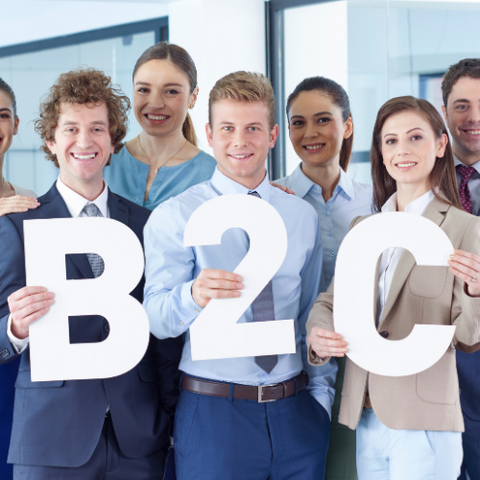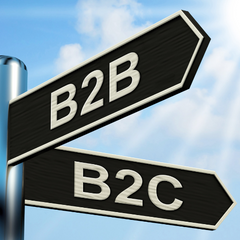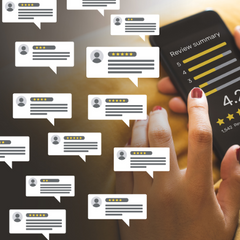
If you're a budding copywriter aiming to make a mark in the world of B2C (Business to Consumer) copywriting, you're in the right place.
In this guide, we'll break down the fundamentals, highlight the distinctions between B2C and B2B copywriting, explore the various types of B2C copywriting, and provide you with 10 actionable tips to enhance your conversion rates.
Let's dive in.
What is B2C Copywriting?

B2C copywriting, short for Business to Consumer copywriting, is the art of crafting persuasive and compelling written content with the primary goal of influencing consumers to take a desired action.
This action could range from making a purchase to signing up for a newsletter or engaging with a brand on social media.
B2C copywriting is about connecting with individuals on a personal level.
Understanding their needs, desires, and pain points, and then using carefully crafted words to motivate them to make a decision in favor of your product or service.
If you want to succeed as a B2C copywriter, you MUST tap into the emotions and aspirations of individual consumers.
It's about creating a relatable narrative that resonates with your target audience, making them feel understood and inspired to take action.
Your key challenge in B2C copywriting is to cut through the noise, grab your audience’s attention, and communicate your message in a way that not only informs but also compels them to make a positive decision.
What is The Difference Between B2C Copywriting & B2B Copywriting?

It’s simple.
B2B copywriting is tailored for business-to-business interactions.
While B2C copywriting is speaking directly to individual consumers.
Understanding the differences between B2C and B2B copywriting is crucial for tailoring your approach to the specific needs of your target audience.
Here's a breakdown of the key distinctions:
1. Audience Focus:
- B2C Copywriting: Targets individual consumers. Emphasizes emotional appeal, lifestyle, and personal benefits.
- B2B Copywriting: Targets businesses and professionals. Focuses on logic, features, and how the product or service can benefit the organization.
2. Decision-Making Process:
- B2C Copywriting: Often involves shorter decision-making processes influenced by emotions, impulse, and personal preferences.
- B2B Copywriting: Involves a more extended decision-making process, influenced by rational considerations, cost analysis, and collaboration between multiple stakeholders.
3. Tone and Style:
- B2C Copywriting: b2c copywriters typically uses a conversational and relatable tone. Emphasizes storytelling and visual elements to engage the audience.
- B2B Copywriting: Adopts a professional and informative tone. Prioritizes data, statistics, and case studies to demonstrate the product or service's effectiveness.
4. Channel Preferences:
- B2C Copywriting: Well-suited for social media, influencers, and visually appealing content. Consumers are often reached through platforms like Instagram, Facebook, and YouTube.
- B2B Copywriting: Thrives in professional settings, such as industry conferences, whitepapers, and LinkedIn. Decision-makers are reached through channels that prioritize business-related content.
By recognizing these differences, you can tailor your copywriting strategies to resonate effectively with either a consumer or business audience.
Now, let's explore the 5 main types of B2C copywriting that you will encounter in your journey.
The 5 Most Popular Types of B2C Copywriting

There are various types of B2C copywriting, each serving a unique purpose in reaching and influencing consumers.
Here are five of the most popular types B2C copywriters write:
- Product Descriptions:
- Objective: Showcase the features, benefits, and uniqueness of a product in a compelling manner.
- Focus: Engaging and informative descriptions that resonate with the target audience's desires and needs.
- Email Marketing Copy:
- Objective: Nurture customer relationships, promote special offers, and drive conversions through targeted email campaigns.
- Focus: Crafting attention-grabbing subject lines and persuasive content that encourages readers to take action.
- Social Media Copy:
- Objective: Increase brand awareness, engagement, and drive traffic to the company's website or landing pages.
- Focus: Short, impactful messages that align with the platform's tone, accompanied by visually appealing elements.
- Website Copy:
- Objective: Provide a seamless and informative user experience, guiding visitors to take desired actions.
- Focus: Clear and concise language that communicates the brand's value proposition, benefits, and encourages conversion.
- Advertising Copy:
- Objective: Capture attention, communicate key selling points, and drive immediate action.
- Focus: Concise and persuasive language, often complemented by visuals, to create memorable and impactful advertisements.
Understanding these distinct types of B2C copywriting allows you to tailor your approach based on the specific goals and platforms, maximizing the effectiveness of your communication with the target audience.
10 B2C Copywriting Tips to Boost Conversions
Tip 1: Know Your Audience

In the world of B2C copywriting, your audience is at the heart of every successful campaign.
To truly connect with them, you need an intimate understanding of who they are, what they value, and the challenges they face.
Start by creating detailed customer personas that outline demographics, interests, and behaviors.
Research their online habits, explore social media trends, and analyze customer feedback.
This wealth of information will be your compass, guiding you to craft copy that resonates authentically. By knowing your audience inside and out, you can tailor your messaging to address their pain points, desires, and aspirations, establishing a genuine connection that forms the basis of persuasive copy.
For instance:
If you're promoting a skincare product, understanding your audience might reveal a focus on natural ingredients, sustainability, or specific skincare concerns. This knowledge allows you to speak directly to their interests, creating a sense of relatability that enhances the effectiveness of your copy.
Look…
Knowing your audience isn't just a tip; it's the cornerstone of persuasive B2C copywriting.
Tip 2: Create Compelling Headlines
In the fast-paced digital world, capturing your audience's squirrel-brained attention is an absolute must.
Crafting compelling headlines requires a mix of persuasion, curiosity, and clarity.
Consider your headline as a stop sign with your ideal reader’s name on it.
It should spark curiosity, highlight a key benefit, or propose a solution to a common problem.
Keep your headlines clear and avoid unnecessary complexity.
Online users often skim content, so your headline must stand out and entice them to leap deeper into your copy.
An effective technique is to focus on the primary benefit your offering brings to the consumer. Whether it's saving time, making more money, or solving a specific problem, make it loud n clear in your headline.
Test different variations to see what resonates best with your audience.
Tip 3: Focus on Benefits, Not Just Features

While features showcase the specifics of your product or service, it's the benefits that truly resonate with your audience.
Consumers are motivated by what a product can do for them.
How it improves their lives, helps them solve a nasty problem or achieve a burning desire.
When crafting your copy, go beyond a mere description of features.
Dive into how those features translate into tangible advantages for the consumer.
Example:
If you're promoting a fitness app, don't just list tracking capabilities and workout options; highlight how these features help users achieve their fitness goals, stay motivated, and lead a healthier lifestyle.
By focusing on benefits, you tap into the emotional side of consumer decision-making, creating a more compelling narrative that encourages action.
Consumers want to know how your product will make a positive impact on their lives, and your B2C copy is the bridge that connects features to meaningful benefits.
Tip 4: Use Persuasive Language
In B2C copywriting, the choice of words can make all the difference.
Persuasive language is your secret weapon to nudge consumers towards action. By selecting words that evoke emotion and prompt a response, you can create a sense of urgency or exclusivity that motivates immediate engagement.
Consider using power words and phrases that resonate with your audience's desires.
Words like "exclusive," "limited time," or "unlock" can instill a sense of privilege, encouraging consumers to take the next step.
Also, tossing in action verbs in your calls-to-action adds a persuasive touch, prompting users to visualize themselves actively participating in the desired outcome.
Remember, the goal is to inspire a response.
A well-crafted message using persuasive language can quickly transform a passive viewer into an engaged customer.
Tip 5: Incorporate Storytelling
Storytelling is a potent tool in B2C copywriting that allows you to create a connection with your audience on a deeper level.
Human beings are wired to respond to narratives.
Storytelling is a VERY effective way to make your copy persuasive, memorable and relatable.
When incorporating storytelling into your copy, focus on real-life scenarios or use cases that highlight the impact of your product or service.
Share success stories, customer testimonials, or personal anecdotes that resonate with the audience's experiences.
This not only makes your copy more engaging but also builds trust and credibility.
A compelling story helps your audience visualize the benefits of your offering in a practical context, making it easier for them to see themselves as satisfied customers.
Whether it's overcoming challenges, achieving goals, or experiencing positive transformations, storytelling adds a human touch to your B2C copy.
Tip 6: Keep it Clear and Concise

After you write your first draft, take a chainsaw and shred all the fluff, fat and fancy talk.
Your B2C copy should communicate its message clearly and concisely, avoiding unnecessary words.
Consumers often skim content, and the key to retaining their attention lies in delivering info in a stupidly simple way.
Start by focusing on your core message.
Clearly articulate what sets your product or service apart and how it addresses the consumer's needs or desires.
Break down information into digestible chunks.
Use bullet points for emphasis, and ensure that each sentence contributes to the overall clarity of your copy.
Avoid jargon or industry-specific terminology that might confuse your audience.
Instead, opt for simple, everyday language that resonates with a broader audience.
Remember, clarity in your B2C copy is not just about what you say but also about how easily your audience can understand and connect with your message.
Tip 7: Leverage the Power of Social Proof

It’s not rocket science.
Consumers are more likely to trust and engage with a product or service when they see evidence of others having positive experiences.
Incorporating social proof into your copy can significantly boost credibility and persuade potential customers to take action.
Social proof can take various forms…
- Testimonials
- Reviews
- Ratings
- Case studies
- Endorsements
Feature genuine testimonials that highlight the positive outcomes your product or service has delivered.
Showcase any notable partnerships, collaborations, or mentions from influencers that reinforce your brand's reliability.
Utilizing social proof not only validates the value of your offering but also helps evaporate concerns and objections potential customers may have.
Whether it's a heartfelt review or a high-profile endorsement, social proof adds a layer of authenticity to your B2C copy, creating trust and increasing the likelihood of conversions.
Tip 8: Optimize for Scannability
In the era of information overload, consumers often scan content rather than reading it thoroughly.
To capture and retain their attention, optimize your B2C copy for scannability.
Break down your content into easily digestible sections, use subheadings, and incorporate bullet points and visuals to enhance readability.
Start with a compelling intro that captures your key message, and then use subheadings to guide readers through the different sections.
Make important points stand out by using bold or italicized text.
Strategically place visuals or infographics to complement your message.
By prioritizing scannability, you cater to the modern consumer's browsing habits, ensuring that even those who quickly skim your copy can grasp the essential information & overall message.
This approach maximizes the impact of your B2C copy, making it accessible and engaging for a broader audience.
Tip 9: Encourage User Engagement
Interactivity is a powerful tool in B2C copywriting to keep your audience engaged and foster a sense of involvement.
Encourage user engagement by incorporating calls-to-action (CTAs) that prompt immediate responses.
Whether it's inviting users to comment on a social media post, participate in a poll, or share their experiences, creating opportunities for interaction helps build a raving community around your brand.
This not only strengthens your relationship with current customers but also attracts new ones through word-of-mouth and social sharing.
Strategically place CTAs throughout your copy, guiding users on the next steps you want them to take.
Tip 10: Harness the Power of Emotion

Without emotion, consumers would not purchase any products.
So…
Your copy needs to tap into your audience’s feelings, pains, desires, and aspirations.
Whether it's joy, nostalgia, fear, or excitement, connecting on an emotional level is an absolute must.
Consider the emotional impact your product or service can have on the lives of your customers. Craft narratives that resonate with their emotions, using relatable situations and language that evoke a genuine response.
Remember, consumers don't just buy products; they invest in experiences and solutions that resonate with their emotions.
By incorporating emotion into your B2C copy, you will skyrocket conversions and create lasting relationships with happy customers.
Conclusion
Alright, enough reading. Time to write.
Use these B2C copywriting tips to help your clients boost results.
Want daily copywriting tips to fly to the top of the copywriting mountain? Enter your email below:
